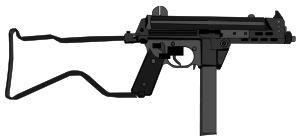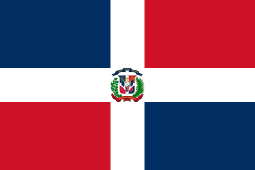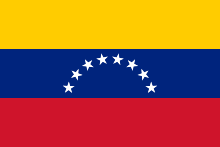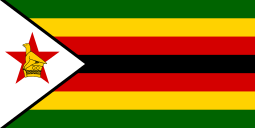Walther MP
The Walther MP (Maschinenpistole) series is a family of 9×19mm Parabellum submachine guns produced in West Germany from 1963 to 1985 by Walther.[2]
| Walther MPK | |
|---|---|
 | |
| Type | Submachine gun |
| Place of origin | West Germany |
| Service history | |
| In service | 1963-present |
| Used by | See Users |
| Wars | Congo Crisis[1] 1972 Munich attack Portuguese Colonial War Carnation Revolution Lebanese Civil War Colombian conflict |
| Production history | |
| Manufacturer | Carl Walther GmbH |
| Produced | 1963—1985[2] |
| Variants |
|
| Specifications | |
| Mass | |
| Length | (w/stock open/closed): |
| Barrel length | |
| Cartridge | 9×19mm Parabellum[2] |
| Action | Blowback[3] |
| Rate of fire | 550 rounds/min[2] |
| Effective firing range | |
| Feed system | 32-round detachable box magazine[2] |
| Sights | Iron sights[2] |
Variants
There are two versions of the Walther MP: the MPK (Maschinenpistole Kurz or "short machine pistol"), illustrated at right, and the MPL (Maschinenpistole Lang or "long machine pistol"). The only difference between MPK and MPL guns is the length of the barrel,[2] and that the MPL has 100 and 200 meter settings.[3]
Description
The mechanism is simple blowback, but with an unusual bolt design, similar in concept but distinct from that of a telescoping bolt. In the Walther, most of the mass of the bolt consists of a hollow tubular weight that is actually placed above and parallel to the barrel, housed in a separate channel in which it reciprocates when the gun is fired. Fixed rigidly to the underside of this heavy tube is an additional steel block that performs most of the tasks of a standard sub-machine gun bolt, that is, this part chambers the rounds and seals them in the chamber, fires them and extracts the empty cartridges. This section is however very small and light in comparison to the bolts of more conventional simple blowback sub-machine guns, as most of the necessary mass and thus inertia is provided by the tubular weight above. This weight extends well ahead of the chamber when the gun is in battery, and also contains the main spring, and so the design is horizontally compact and permits both guns to feature relatively long barrels for their overall length. The receiver is made from stamped steel, with plentiful ventilation slots; and the prominent cocking handle is located on its left front. A selective fire switch is also on both the left and right side of the receiver, behind the trigger, allowing for ambidextrous use.[3]
Both guns feature side-folding buttstocks, made from thin steel tubes wrapped in a rubber coating.
Users










See also
References
- Abbot, Peter (February 2014). Modern African Wars: The Congo 1960–2002. Oxford: Osprey Publishing. p. 46. ISBN 978-1782000761.CS1 maint: ref=harv (link)
- Hogg, Ian (2002). Jane's Guns Recognition Guide. Jane's Information Group. ISBN 0-00-712760-X.
- http://modernfirearms.net/smg/de/walther-mpl-e.html
- Jones, Richard D. Jane's Infantry Weapons 2009/2010. Jane's Information Group; 35 edition (January 27, 2009). ISBN 978-0-7106-2869-5.
- Griswold, Terry and D.M. Giangreco. Delta: America's Elite Counterterrorist Force. Osecola, WI: MBI Publishing Company, 1992. ISBN 0-87938-615-0.
- James, Stejskal (2017). Special Forces Berlin : clandestine Cold War Operations of the US Army's Elite, 1956-1990. Philadelphia. ISBN 9781612004440. OCLC 974913834.